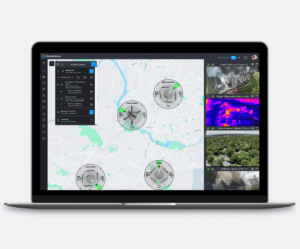 Texas law teams up with Austin-based drone software company
Texas law teams up with Austin-based drone software company
By DRONELIFE Staff Writer Jim Magill
Picture a search and rescue mission in which a hiker is lost in a remote brush-covered region of West Texas. The state’s premier law enforcement agency, the Department of Public Safety, launches several drones to conduct the search, as does the local sheriff’s department.
An application provided by Austin-based drone software developer DroneSense is helping incident commanders on the ground to coordinate the flight of the multiple unmanned aerial vehicles, and providing greater situational awareness of the entire scene.
On Tuesday the company announced that DPS had awarded DroneSense a multi-year contract to provide the agency the tools “to improve situational awareness by centralizing and integrating massive data sets, and creating the ideal environment for multiple agencies to collaborate and work together effectively to face any public safety crisis.”
The DroneSense platform allows drone “pilots, operators and administrators to communicate easily and effectively with one another and share mission-critical information.” The software is hardware-agnostic, meaning it can be used by agencies operating drones produced by multiple manufacturers, including DJI, Parrot and Autel. It can also be run on both iOS and Android phones and tablets.
“There’s an entire collaboration piece that allows pilots to collaborate in real time, not only from one agency, but they can connect with multiple agencies on the same scene and they can be sharing video and telemetry and geospatial information,” DroneSense CEO Chris Eyhorn said in an interview.
Eyhorn said the software provider has had a “laser-beam focus on public safety” since its founding in 2015. “We believe the use of drones in their space can fundamentally change how fire service, police agencies and emergency management services do their jobs,” he said.
The DPS, which has a fleet of more than 100 small unmanned aerial vehicles, uses drones across its broad range of missions including: law enforcement, counterterrorism, disaster response and search and rescue. The agency also offers drone operation training at its facility in Florence, Texas, where UAS operators from agencies across the state and country are trained in real-world situations including night operations, search and rescue and clearing buildings.
DPS “has really been a leader in the public safety space,” Eyhorn said. The agency is at the forefront of adopting and operationalizing the drone-related technology.
Contract continues existing cooperation
The agreement announced this week continues an existing relationship between DPS and DroneSense.
“The contract allows us to more quickly add more drones and more products to the platform,” Eyhorn said. “For us as a company, the contract is also an endorsement of the value that we’re bringing them and the value that they’re able to show the state of Texas in having a large program like this.”
In order to ensure its applications can run in conjunction with drones produced by different manufacturers, DroneSense’s software implements each manufacturers’ software development kit (SDK).
“We translate that into our own DroneSense SDK,” Eyhorn said. “The rest of the platform and every other feature is built on top of our SDK. When we have a new drone from a manufacturer that we’d like to support, all we have to do is translate its software development kit into the DroneSense SDK and then all of a sudden, it fully participates in the rest of the ecosystem.”
In its contract with DPS, the agency deploys the DroneSense software to increase its situational awareness in a number of different kinds of operations where drones are deployed: search and rescue, overwatch of a SWAT raid, or apprehending fleeing suspects.
“During a disaster response, everybody’s running DroneSense. If they have multiple drones up, it allows them to geospatially see where all the drones are but more importantly, to see where they have been,” he said. The software allows incident commanders on the ground to tie together into a single picture the flight paths flown by all the drones involved in the operation during a given period of time.
“It makes multi-drone operations very seamless, where without a tool like this, it becomes very complex,” Eyhorn said. “The commanders are able to get a clear picture of where they’ve flown and where they haven’t.”
Software aids in search operations
In the case of a search and rescue operation in which a hiker calls 9-1-1 after falling and breaking his leg, the dispatcher gives the drone pilot the correct latitude/longitude position and the pilot can quickly punch the data into the application, marking the location of the incident.
“That marker will be shared with all the other pilots in the ops center and they can click a button and [the drone] will fly autonomously to that maker and they can have real-time video feed and help guide the rescue teams,” Eyhorn said.
DroneSense recently released a mobile streaming and tracking app, which can run on mobile devices, allowing searchers on the ground – even four-footed ones – to transmit video and be tracked in real time in the same way the aerial vehicles are.
“We can now bring in non-drone assets and be able to livestream the video from those devices all into the back end,” Eyhorn said.
Using this app, searchers can strap a cell phone onto the neck of a search and rescue dog and let the dog loose to find the injured party. “The pilot can see exactly where the dog is and can fly the drone to follow it.”








[…] its drone-collected data, the department employs the DroneSense software platform, which offers a Department of Defense-rated encrypted network, not accessible to unauthorized persons. The software tracks and records every drone flight, which […]